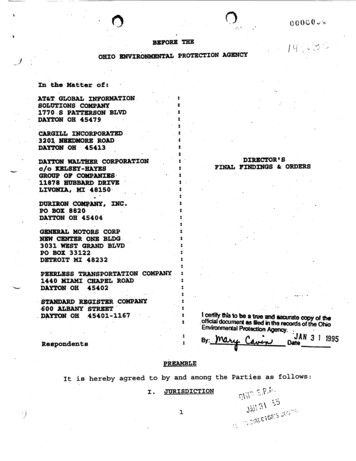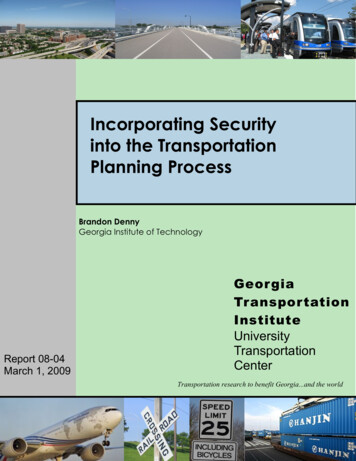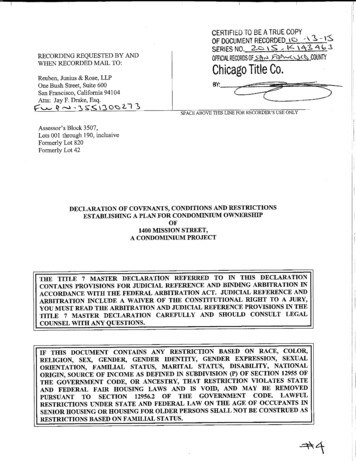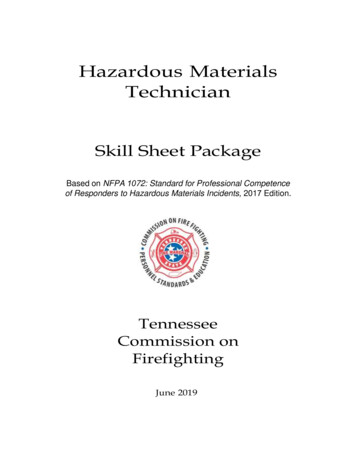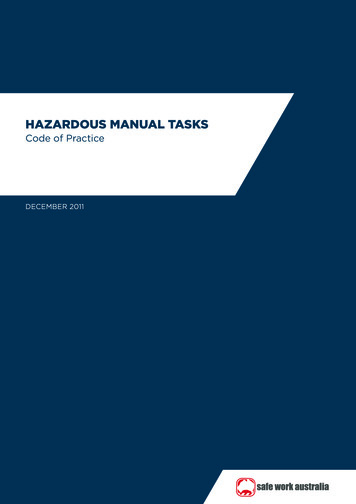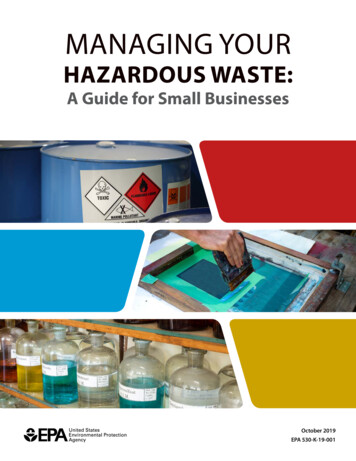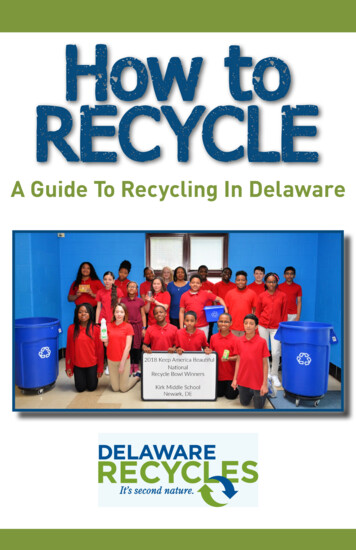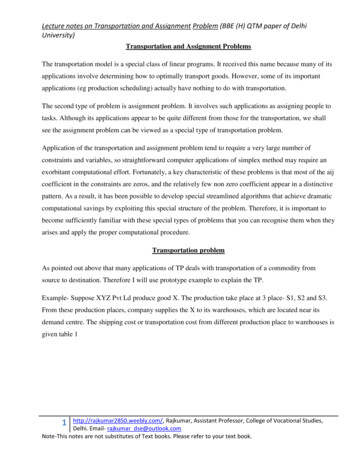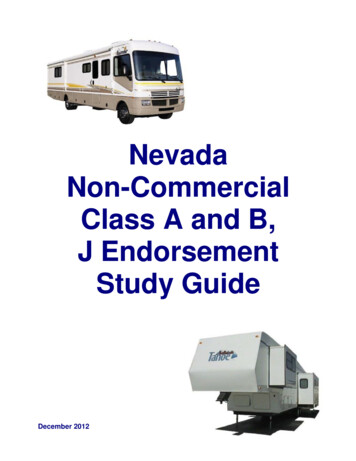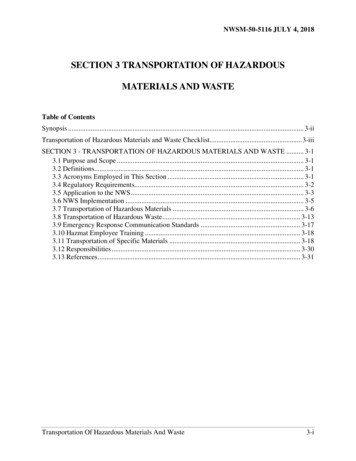
Transcription
NWSM-50-5116 JULY 4, 2018SECTION 3 TRANSPORTATION OF HAZARDOUSMATERIALS AND WASTETable of ContentsSynopsis . 3-iiTransportation of Hazardous Materials and Waste Checklist. 3-iiiSECTION 3 - TRANSPORTATION OF HAZARDOUS MATERIALS AND WASTE . 3-13.1 Purpose and Scope . 3-13.2 Definitions. 3-13.3 Acronyms Employed in This Section . 3-13.4 Regulatory Requirements. 3-23.5 Application to the NWS . 3-33.6 NWS Implementation . 3-53.7 Transportation of Hazardous Materials . 3-63.8 Transportation of Hazardous Waste. 3-133.9 Emergency Response Communication Standards . 3-173.10 Hazmat Employee Training . 3-183.11 Transportation of Specific Materials . 3-183.12 Responsibilities . 3-303.13 References . 3-31Transportation Of Hazardous Materials And Waste3-i
NWSM-50-5116 JULY 4, 2018SynopsisNOTE:The purpose of this section is to provide information regarding the application of theDepartment of Transportation (DOT) regulations to hazardous materials transportedby or offered by NWS personnel. The section applies to all NWS facilities, worksites, and employees.Initial Implementation Requirements: Appoint a Designated Person to coordinate hazardous material transportation (3.6)Identify Scope of Applicability at Site/Facility Operations with the Requirements of thisSection Identify all hazardous materials transported by NWS employees (3.6) Identify all hazardous materials and wastes transported by a contracted service provider(3.6) Prepare a “short list” of site-specific hazardous material and hazardous waste shippingdescriptions using 3.7.2 and 3.11Recurring and Annual Task Requirements: Meet with Transporter to Identify and Verify Shipping Descriptions, Labeling and Markingto be used on Containers and Shipping Documents during Length of Contract.Periodically (at least semi-annually), Inventory Types and Quantities of Hazardous MaterialsTransported Off-site by NWS Personnel for Use at Remote Work Locations (3.6)Train Affected Personnel in Their Role of Ensuring Compliance with DOT and EPATransportation Requirements (3.6, 3.10)Inspect Labeling, Marking and Paperwork Prepared by Transportation Service Provider Priorto Signing Shipping Document and Releasing Hazardous Materials/Hazardous Waste forTransportation (3.6)Ensure Signed Copy of Hazardous Waste Manifest is Returned From the Treatment, Storageand Disposal Facility (TSDF) Within 45-DaysTransportation Of Hazardous Materials And Waste3-ii
NWSM-50-5116 JULY 4, 2018Transportation of Hazardous Materials and Waste Checklist1.YES NO NAHas the work site identified all the hazardous materials regulated by theU.S. Department of Transportation (DOT) that are transported by NWSemployees? (3.6)―――Have all NWS employees who transport these hazardous materialsreceived instruction on proper labeling and marking as well as methodsto secure these materials during transport? (3.6, 3.10)―――3.Have all DOT hazardous materials that are transported from the facilityor work site by a contracted hauler been identified? (3.6)―――4.Has a listing been prepared for each DOT hazardous material identifyingthe material, its proper shipping name, the appropriate markings, andallowable shipping containers to be used?―――2.Transportation Of Hazardous Materials And Waste3-iii
NWSM-50-5116 JULY 4, 2018SECTION 3 - TRANSPORTATION OF HAZARDOUS MATERIALS AND WASTE3.1Purpose and ScopeNational Weather Service (NWS) operations utilize many different hazardous materials, bothat NWS facilities and/or at remote locations. Because these materials are transported byNWS personnel when specific maintenance activities are undertaken, the Department ofTransportation (DOT) Hazardous Material Regulations (HMR) must be considered to assuresafe transport. This section addresses the application of these rules to NWS facilities andpersonnel and provides specific guidance for typically transported hazardous materials.3.2DefinitionsLabeling3.3The application of hazard warning labels as prescribed in the HazardousMaterials Table.MarkingThe descriptive name, instructions and cautions designated for ahazardous material in 49 CFR 172.300. Marking includes the propershipping name, the identification number, other regulated material(ORM) designations, internal packaging, and specific requirements forvarious types of tanks.OperatingUnitIncludes the National Centers for Environmental Prediction (NCEP),National Data Buoy Center (NDBC), NWS Training Center (NWSTC),National Reconditioning Center (NRC), National Logistics SupportCenter (NLSC), Radar Operations Center (ROC) or the Sterling FieldSupport Center (SFSC).PlacardingThe application of DOT-designed hazard warning sign(s) to the outsideof the shipping vehicle.StationManagerFor the purpose of this procedure, the Station Manager shall be eitherthe NWS Regional Director; NCEP Director; Directors of Centers underNCEP (Aviation Weather Center, NP6; Storm Prediction Center, NP7;Tropical Prediction Center, NP8, and Space Weather Prediction Center,NP9); Directors of the NDBC, NWSTC, and Chiefs of NRC, ROC andSFSC facilities; or Meteorologist in Charge (MIC), Hydrologist inCharge (HIC), or Official in Charge (OIC).Acronyms Employed in This SectionASOSAutomated Surface Observation SystemCERCLAComprehensive Environmental Response and Compensation LiabilityActCFRCode of Federal RegulationsCHEMTRECChemical Manufacturers Transportation Emergency CenterCONUSContinental United StatesCOTRContracting Officer’s Technical RepresentativeTransportation Of Hazardous Materials And Waste3-1
NWSM-50-5116 JULY 4, 20183.4DOTDepartment of TransportationEPAEnvironmental Protection AgencyERGEmergency Response GuidebookHMHazardous MaterialHMRHazardous Materials RegulationsHMTHazardous Materials TableHMTAHazardous Materials Transportation ActHMTUSAHazardous Materials Transportation Uniform Safety ActLARCLimited Access Remote CollectorMCEMercury Containing EquipmentSECONOAA Environmental Compliance and Safety OfficeNOAANational Oceanic & Atmospheric Administrationn.o.s.not otherwise specifiedN/ANot ApplicableNWSNational Weather ServiceNWSHNational Weather Service HeadquartersORMOther Regulated MaterialPGPackaging GroupRCRAResource Conservation and Recovery ActRDARadar Data AcquisitionRQReportable QuantityTSDFTreatment, Storage, and Disposal FacilityUN/NAUnited Nations/North American (numbering system)Regulatory Requirements3.4.1 Federal Legislationa. The Hazardous Materials Transportation Act (HMTA) of 1974 required the Departmentof Transportation (DOT) to identify hazardous materials, which would pose a danger tohealth and safety while in transit, and to specify identification, labeling, packaging andplacarding requirements as a means of managing these hazards during transportation.The Hazardous Material Regulations (HMR) are found in 49 CFR Parts 171-180.b. The Hazardous Materials Transportation Uniform Safety Act (HMTUSA) of 1990amends the HMTA with additional requirements.c. The Resource Conservation and Recovery Act (RCRA) regulates the storage,transportation, and disposal of hazardous waste. While maintaining specific requirementsTransportation Of Hazardous Materials And Waste3-2
NWSM-50-5116 JULY 4, 2018for waste transporters, the Environmental Protection Agency (EPA) expressly adopts theDOT regulations for the transportation of hazardous waste. These regulations specify therequirements for labeling, marking, placarding, use of proper containers, and reporting ofdischarges. The adoption of the DOT rules to hazardous waste shipments ensuresconsistency and avoids duplication of conflicting transportation requirements. Both EPAand DOT have enforcement authority over hazardous waste shipments regardless of theother agency’s enforcement action (or inaction).3.5Application to the NWS3.5.1 Exemption for Federal GovernmentThe HMTA and HMTUSA apply to “any person” who transports hazardous materials incommerce. The NWS, as an organization within the Federal Government, is included as a“person” and thereby subject to the DOT Hazardous Materials Regulations (HMR). The term"commerce" means transport within state, or across state lines. An exemption to the HMRapplies for federal employees transporting hazardous materials in a government vehicle whenundertaken solely for a governmental function versus a commercial activity. (See 49 CFR171.1(d)(5), transportation of a hazardous material in a motor vehicle, aircraft, or vesseloperated by a Federal, state, or local government employee solely for noncommercial Federal,state, or local government purposes is a function not subject to the requirements of the HMR).DOT has defined government activity to be commercial whenever it furthers a commercialenterprise, replaces a commercial enterprise or is in in competition with the private sector.NOTE: Although the DOT does not regulate the transportation of Hazardous Materials whendone by NWS employees in a NWS (or government) vehicle for a governmental purpose, theNWS recognizes the DOT rules are designed to facilitate the safe transport of these materials.To ensure employee safety and facilitate appropriate response in the event of an accident,NWS policy requires NWS personnel to apply the DOT rules for packaging, labeling andmarking of containers. Although this policy does not require the use of DOT shippingpapers, a list of hazardous materials and the quantity being transported shall accompany thematerial transport. Furthermore, it is recommended that MSDSs/ SDSs for transportedhazardous materials are available for use in case of emergency.How does this affect the NWS?a. The HMR do not apply to the transportation of operationally necessary hazardousmaterials from NWS facilities transported in government vehicles, by NWS employees toNWS remote work sites/locations.b. The HMR do not apply to the transportation of operationally necessary hazardousmaterials and hazardous waste used and/or generated at the remote work site/locations fortransport back to a NWS facility as long as it is undertaken by NWS personnel using agovernment vehicle.c. The HMR do apply to any entity contracted by NWS personnel to transport a hazardousmaterial or waste either to or from a NWS facility or remote work site/location.Transportation Of Hazardous Materials And Waste3-3
NWSM-50-5116 JULY 4, 2018NOTE: In this circumstance, it is the use of the contractor’s employees and/or its vehicle(i.e. including vessel and aircraft) that defines the transport as “furthering a commercialenterprise.” This transport is not covered as a governmental activity and the transportermust comply with the HMR.d. The HMR do apply to the transportation of hazardous waste to a treatment, storage ordisposal facility by NWS personnel, using a government or private vehicle. According tothe Environmental Protection Agency (EPA) regulations for hazardous waste in 40 CFRParts 262 (Standards Applicable to Generators) and 263 (Standards Applicable toTransporters) HW transporters must have an EPA Identification Number. Because it isnot in the mission of the NWS scope of responsibilities to transport hazardous waste anddue to the legal consequences potentially associated with this activity, the transportationof hazardous wastes to permitted treatment and disposal facilities by NWS personnel isprohibited.NOTE:With the growing awareness of the hazardous nature of the garbage being disposed inlocal garbage landfills, many communities have set-up periodic “household hazardouswaste” collection days to segregate and/or recycle certain types of waste. Dependingupon the requirements established by the community, NWS facilities may be able toparticipate. Before transporting any waste generated at an NWS facility or worklocation, contact the local program officials to determine whether the NWS facility, asa Federal government activity and generator of hazardous waste, can participate and ifthere are any special requirements regarding the transportation of the waste to thecollection site (needed documents, permits, etc.).e. The HMR may apply to the transportation of computer central processing units (CPUs)and cathode ray tubes (CRTs) or monitors. Currently the EPA regulates them ashazardous wastes and hence they can only be transported by a registered hauler. Becausethe EPA is proposing to regulate these as universal wastes, as some States currently aredoing, they are regulated under the DOT rules. Some States are regulating them ascontrolled scrap metal for recycling and as a result, requiring a registered hauler be used.f. The HMR are issued for the safe transportation of hazardous materials in intrastate,interstate and foreign commerce with applicability in the United States, District ofColumbia, Commonwealth of Puerto Rico, the Commonwealth of the Northern MarianaIslands, the Virgin Islands, American Samoa, Guam and any other possession sodesignated.This means that NWS facilities and work locations in any of these foreign countries mustapply the same interpretation of “government activity versus furthering a commercialenterprise” when transporting hazardous materials and/or waste. It is NWS policy that allNWS activities including facilities in other than the Continental United States (CONUS)locations ensure, to the best of their ability that contracted transportation services complywith all applicable HMR. Consult with the NWS Regional/Operating UnitEnvironmental/Safety Coordinator or NWSH Environmental and Safety staff foradditional advice.Transportation Of Hazardous Materials And Waste3-4
NWSM-50-5116 JULY 4, 20183.6NWS ImplementationThe first task is to assign a Designated Person to coordinate the hazardous materialstransportation effort. This role is normally tasked to the Environmental Focal Point, but maybe assigned to another NWS employee. To help coordinate the implementation at NWSwork sites, an inventory must be taken to identify all hazardous materials transported byNWS employees. Additionally, another inventory will be generated of all hazardousmaterials and wastes transported by contracted service providers. These inventories will helpidentify the level of effort necessary and additional site personnel requiring training.The DOT regulations affect any person who offers a hazardous material for transportation,each carrier who transports a hazardous material and anyone else who performs a packaging,labeling or marking function.Typically, contractors are used by the NWS to either deliver needed hazardous materials orto pick up waste for disposal or recycling. As a result, the involvement of NWS employeeswith the DOT rules can appear minimal because the contractor usually “prepares” theshipping document/manifest, ensures proper packaging are used and even attaches DOTlabels.But, because the DOT identifies the “offeror,” the “transporter” and “others” whose role canaffect the transported material, the NWS and its employees at most locations are still boundby these rules.The Environmental Focal Point or Designated Person must ensure that all work performed bythe contracted provider be checked periodically to ensure compliance with applicable rulesbecause by signing the prepared shipping paper, the NWS representative is certifying that theshipment has been prepared in accordance with the DOT rules and as a result, the NWSassumes liability for compliance.3.6.1 Contract LanguageWhen using a contractor to transport, treat, or dispose of a hazardous waste, the NWS doesnot transfer legal liability for improper management with the physical transfer of the waste.The NWS remains liable long after the waste is gone. As a result, all new and existingcontracts must be carefully scrutinized to maintain minimum liability for the NWS and itsemployees. All contracts must be reviewed to assure that the contract clearly mandates thatthe contractor comply with the law. With the assistance of the Contracting Officer’sTechnical Representative (COTR), review all existing contracts to ensure they include aphrase mandating the contractor to “comply with all applicable Federal, State, and local lawspertaining to the proper transportation, management, and disposal of wastes and materials.”3.6.2 Review of the Transportation Contractor (Hauler)Before using the services of a transportation contractor, contact the NWS Regional/OperatingUnit Environmental/Safety Coordinator or NWSH Environmental and Safety staff todetermine if the hauler is registered to transport hazardous materials and/or waste and todetermine the hauler’s compliance history.Also, determine if there are pending citations or other legal sanctions for improper or illegaltransportation practices by the hauler. If so, how have these been resolved? What is thecurrent enforcement status of the hauler?Transportation Of Hazardous Materials And Waste3-5
NWSM-50-5116 JULY 4, 2018In addition, in the investigatory interview, a determination must be made as to whether thehauler has sufficient resources and/or the necessary insurance to protect the NWS fromunexpected liabilities if accidents or mishandling occurs during transportation. Again, theCOTR can provide assistance in this effort.3.7Transportation of Hazardous Materials3.7.1 Hazardous Material TableThe DOT designates materials as hazardous by listing them upon the Hazardous MaterialsTable (HMT). The HMT is an alphabetical list of commodities or items that identifies:a. The material’s hazard class or that the material is forbidden in transportationb. The proper shipping name or direction to the preferred proper shipping namec. Specific references or references to requirements in the HMR pertaining to labeling,packaging, quantity limits aboard aircraft and stowage of hazardous materials aboardvessels.The HMT consists of ten (10) columns of information that is used to fulfill the requirementsfor a given shipment. The HMT is found in 49 CFR 172.101. Due to its length and on-goingpotential for revision, reference a current copy at DOT HMT.Appendix A to the HMT is the List of Hazardous Substances and Reportable Quantities. TheAppendix lists materials and their corresponding reportable quantities (RQs) that aredesignated as “hazardous substances” by CERCLA. It is used to determine the need foradditional information to be provided on shipping documents and containers. Because theEPA has the legal responsibility to determine the reportable quantities for the DOT, theseRQs can be found in Appendix B to this manual.3.7.2 Shipping PapersAnyone who offers a hazardous material for transportation is required to describe thematerial on a shipping paper as specified in 49 CFR 172.200-204. This documentaccompanies the shipment to its destination and serves as a record of the shipment, thetransporter used and final disposition of the hazardous materials shipped from NWS facilitiesand work locations.a. General EntriesWhile non-regulated items may be included on the same shipping paper as regulatedhazardous materials, the hazardous material entries must be identified as denoted in§172.201(a)(1).b. Contents1) All copies of shipping papers must be legible and printed (mechanically or manually)in English.2) Unless allowed, no abbreviations may be used in the description.3) Additional information about the material may be added, but it must be placed afterthe “basic description.”Transportation Of Hazardous Materials And Waste3-6
NWSM-50-5116 JULY 4, 20184) If more than one sheet is necessary, ensure that it is sequentially numbered indicatingthe number of pages (i.e., 1 of 4 pages).c. Emergency Response Telephone NumberA 24-hour emergency response telephone number for use in the event of an emergencyinvolving the shipped hazardous material must be provided on the shipping paper. Thenumber must have immediate access to a person who is knowledgeable of the materialand emergency response mitigation information for the materialNOTE:DOT shipping papers are not required for transportation of hazardous materials ingovernment vehicles. However, a list of hazardous materials and the quantity beingtransported shall accompany the material transport. Furthermore, it is recommendedthat MSDSs/SDSs for transported hazardous materials are available for use in case ofemergency.d. Description of Hazardous Material on Shipping PapersThe “shipping description” of a hazardous material on shipping papers must include thefollowing items in the following order:1) The proper shipping name as prescribed in column 2 of the HMT2) The hazard class or division prescribed in column 3 of the HMT3) The identification number prescribed in column 4 of the HMT4) The packaging group in roman numerals prescribed (if any) in column 5 of theHMT, preceded by “PG”5) The total quantity, by net or gross mass, capacity or other appropriate units (use ofabbreviations is allowed).As an example, the proper shipping description for 25-gallons of gasoline would be:“Gasoline, 3, UN 1203, PG II, 25 gals.”e. Additional Description RequirementsThe following additional requirements found in 49 CFR 172.203 may apply whendescribing a hazardous material.1) Exemptions - when a shipment is made under an exemption, it must bear the notation“DOT-E” followed by the exemption number.2) Limited Quantities - if an item meets the requirements for a limited quantity, thewords “Limited Quantity” or “Ltd Qty” must follow the basic description.3) Hazardous Substances - if a hazardous substance description does not identify thesubstance by name (i.e. flammable liquid, not otherwise specified (n.o.s.)), the nameof the hazardous substance will be entered in parentheses in association with the basicdescription.a) For mixtures of hazardous materials containing two or more hazardoussubstances, the name of the two hazardous substances with the lowest RQs mustbe identified.Transportation Of Hazardous Materials And Waste3-7
NWSM-50-5116 JULY 4, 2018b) For hazardous waste streams, the waste code (e.g. D001) may be used to identifythe waste.The letters “RQ” (for reportable quantity) must be noted before or after the basicdescription if the material/waste is listed on Appendix A to the HMT and the quantityin an individual package contains an amount equal to or greater than the RQ listed forthe material.4) Radioactive material - additional notations are required in 49 CFR 172.203(d).5) Empty packaging - a description for a packaging containing the residue of ahazardous material may include “Residue: Last Contained” in association with thebasic description of the hazardous material last contained in the package.6) Transport by air - additional notations as required by 49 CFR 172.203(f).7) Transport by rail - additional notations as required by 49 CFR 172.203(g).8) Transport by highway - additional notations as required by 49 CFR 172.203(h) forshipments of anhydrous ammonia and liquefied petroleum gas.9) Transport by water - additional notations as required by 49 CFR 172.203(i).10) Technical names for not otherwise specified or “n.o.s.” descriptions - if one of theproper shipping names shown on the HMT with a “G” in column 1 is utilized, thetechnical name of the hazardous material must be entered in parentheses inassociation with the basic description (i.e. Corrosive liquid, n.o.s., (sodiumhydroxide) 8, UN 1760, PG II).11) Marine pollutants listed on Appendix B to the HMT have special considerations.Where the proper shipping name does not identify by name the component that makesthe material a marine pollutant, the name of the marine pollutant must be entered inparentheses in association to the basic description. If a mixture contains two or moremarine pollutants, the names of at least two most predominately contributing to themarine pollutant designation must appear in parentheses.a) The words “Marine Pollutant” shall be designated in association to the basicdescription that is a marine pollutant.b) Except for transport by vessel, this requirement does not apply to oil (asdesignated in 49 CFR 130) as long as the proper shipping name identifies thematerial as such.12) Poisonous material - regardless of the hazard class to which a material is assigned, thefollowing requirements apply to poisonous materials:a) If a Division 6.1, PG I or II solid or liquid material whose shipping name orclass does not disclose that it is a poison, the words “Poison” or “Toxic” mustbe entered on the shipping paper in association with the description.b) Materials poisonous by inhalation must be marked “Poison-InhalationHazard” or “Toxic Inhalation Hazard.” Additionally, if a gas, “Zone A, or B,or C, or D” shall be entered following the shipping description. If a liquid,“Zone A or B” as appropriate.Transportation Of Hazardous Materials And Waste3-8
NWSM-50-5116 JULY 4, 201813) Elevated temperature materials - the word “HOT” must be noted preceding the propershipping name if a liquid material meets the definition in §171.8.14) Organic peroxides (Class 5.2) and self-reactive (Class 4.1) materials must includeadditional information as required by 49 CFR 172.203(o).f. Each shipping document must contain a certification as specified in 49 CFR 172.204 toassure that the described materials have in all respects met the applicable requirementsof the DOT. Additional certification requirements are specified for transport by cargoand passenger aircraft and for radioactive materials.3.7.3 Marking and LabelingWhen a material is offered for shipment, each container must be properly marked andlabeled. While one often assumes these terms have the same meaning, the DOT specifiestwo distinct regulatory programs to accomplish the identification of hazardous materials.Marking is defined by the DOT as the application of the descriptive name, instructions andcautions designated in 49 CFR 172.300. Marking includes the proper shipping name, theidentification number, ORM designations, internal packaging, and specific requirements forportable tanks, cargo tanks, tank cars, and radioactive materials. This information may beapplied directly to the container with paint, marker, etc. or on an adhesive-backed sticker.Labeling requirements are found in 49 CFR 172.400 and specify the application of hazardwarning labels prescribed in the HMT. Additional labeling requirements are specified forradioactive materials and multiple hazard materials and packaging.In general, labeling is the application of the DOT hazard warning labels specified in theHMT and marking is the application of other required information on the container.NOTE:Appendix D to this Manual is a freeware program entitled “Hazardous Waste Labels.”This is a WORD document, which can be used to print many of the markings andlabels required for typical wastes generated by the NWS.a. MarkingAnyone who offers a hazardous material for transport must mark each package, freightcontainer and transport vehicle containing a hazardous material according to 49 CFR 172Parts 300-338.The following summary identifies selected markings for hazardous materials in non-bulkpackaging:1) The proper shipping name as it appears in the DOT HMT column 2 (49 CFR172.301).2) The identification number as it appears in column 4 of the DOT HMT. The numberis not required on packages of “limited quantities” or ORM-D material.3) The proper shipping name for a hazardous waste is not required to include the word“waste” if the package bears the EPA marking as required by 40 CFR 262.32.4) The technical chemical name of the hazardous material or substance must be markedTransportation Of Hazardous Materials And Waste3-9
NWSM-50-5116 JULY 4, 2018in parentheses if column 1 of the HMT indicates a “G”, and/or the selected shippingname does not otherwise identify the chemical/material (49 CFR 172.301 and172.324).5) Packages containing inner containers of liquid hazardous material must be markedwith the “this end up” arrow designation. There are numerous exceptions to thisrequirement (see 49 CFR 172.312).6) The words “Inhalation Hazard” must be marked on packages of poisonous inhalationmaterials (49 CFR 172.313).7) Materials classified as a consumer commodity must be marked ORM-D or ORM-DAir if being transported by air (49 CFR 172.316).8) Marine pollutants shipped by vessel and/or in bulk quantities must be marked asspecified (49 CFR 172.322).9) The letters “RQ” (for reportable quantity) must be displayed in association with theproper shipping description for each package containing the reportable quantity of ahazardous substance (49 CFR 172.313).The required markings must be: DurableIn EnglishPrinted or affixed to the surface of a package or a label, tag or signDisplayed on a background of a contrasting colorUnobstructed by labels or attachmentsLocated a
National Data Buoy Center (NDBC), NWS Training Center (NWSTC), National Reconditioning Center (NRC), National Logistics Support Center (NLSC), Radar Operations Center (ROC) or the Sterling Field Support Center (SFSC). Placardin g The application of DOT-designed hazard warning sign(s) to the outside of the shipping vehicle. Station Manager
